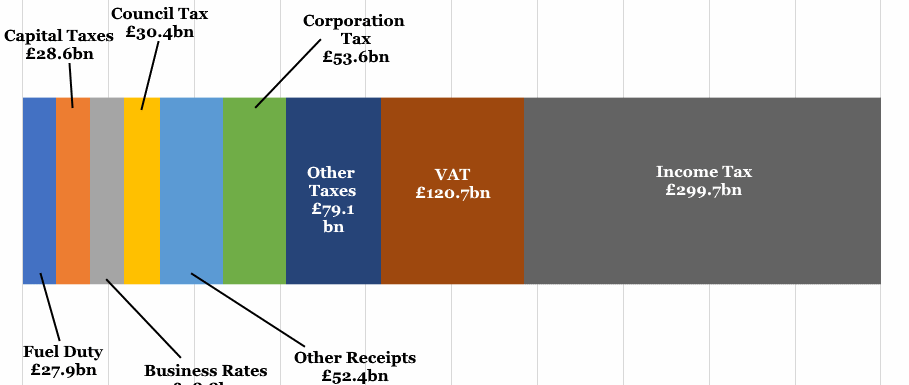Summary
As the general election approaches, these charts provide some information on the current state of taxation receipts and public spending in the UK. The UK government has run a budget deficit as a norm over the last 60 plus years, as expenditure is higher than tax revenue, regardless of which party occupies Downing Street. The budget was last balanced in 2001/2 and has been so in only 8 of the years since 1955. The OBR forecasts debt to be equivalent to 86.6% of national income in 2016/17, equating to around £1,730 billion or £62k per household. They also forecast total tax revenue of £721.1 billion, again falling short of planned expenditure of £772.8 billion.
What do the charts show?
Representing the fiscal year from April 2016 to March 2017, the figures presented in this chart compare projections of public sector of spending with receipts. The stacked bars represent the projected total and the breakdown by category of public sector spending and the sources of public sector tax receipts. Although each component is labelled with the absolute amount it represents, along the horizontal axes, the percentages of the total are shown.
Why are the charts interesting?
The taxes that contribute most to the public purse are income tax including National Insurance Contributions and VAT, which are anticipated to raise a combined £421bn. One sizeable contribution comes from corporation tax which represents 7.4% of the total. Business rates, Council and Capital Taxes and Fuel Duty each currently contribute around 4% of the total. Among the ‘other’ tax revenue is income from interest on assets for example FX reserves or student loans alongside income from corporations that remain in public hands.
Expected public spending per household will total £28k or 39.3% of household income this year. Unsurprisingly, spending on health is the largest in a single sector, an estimated 15% of the total. It is noteworthy that the NHS employs over 1.5 million people, and sits among the US Department of Defence, McDonalds and Walmart in the top five largest global workforces. Similarly, education demands a sizeable government expenditure, thought to account for 7.7% of total spend at £59.6 billion. Other expenditure covers day-to-day running costs of the machinery of the state including public services, grants and administration- around some 40% overall.



